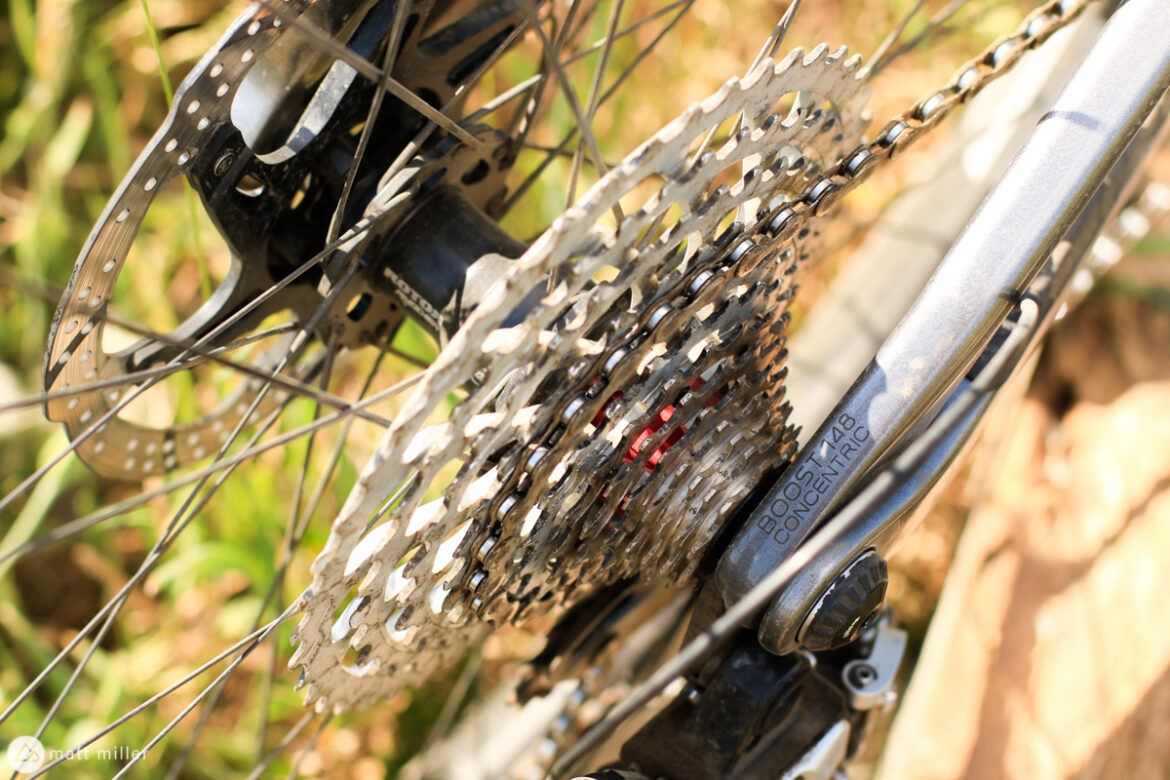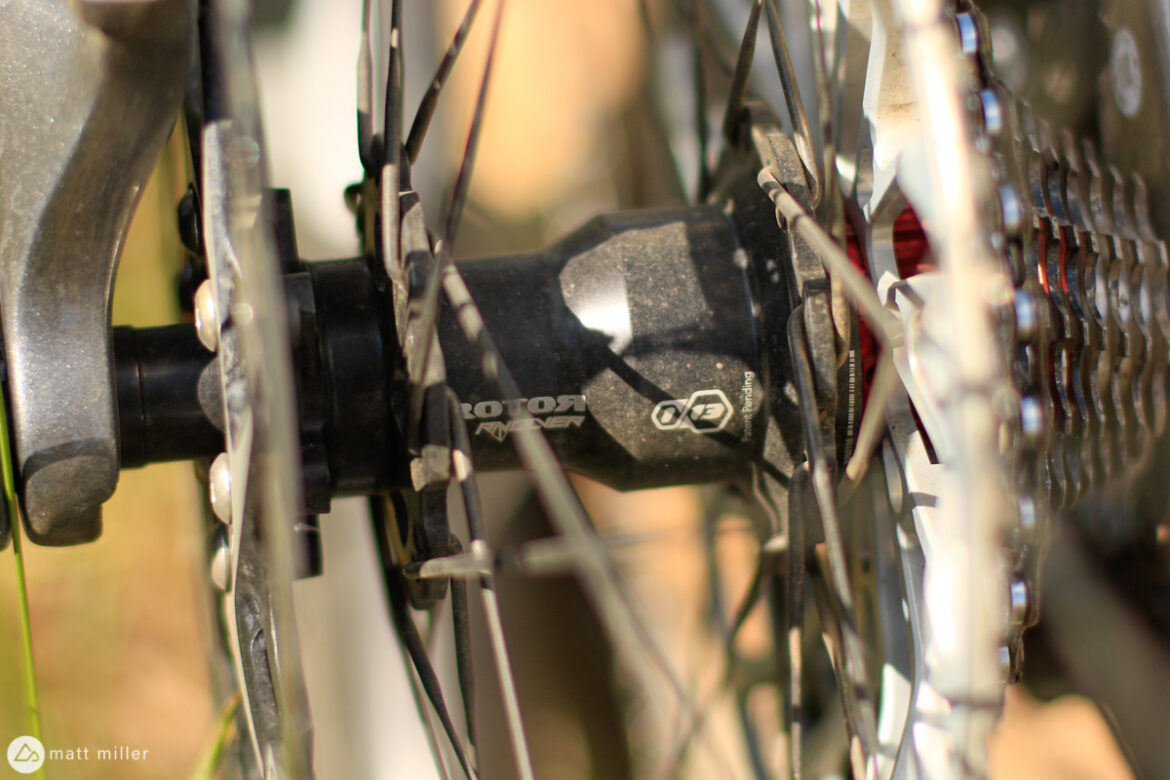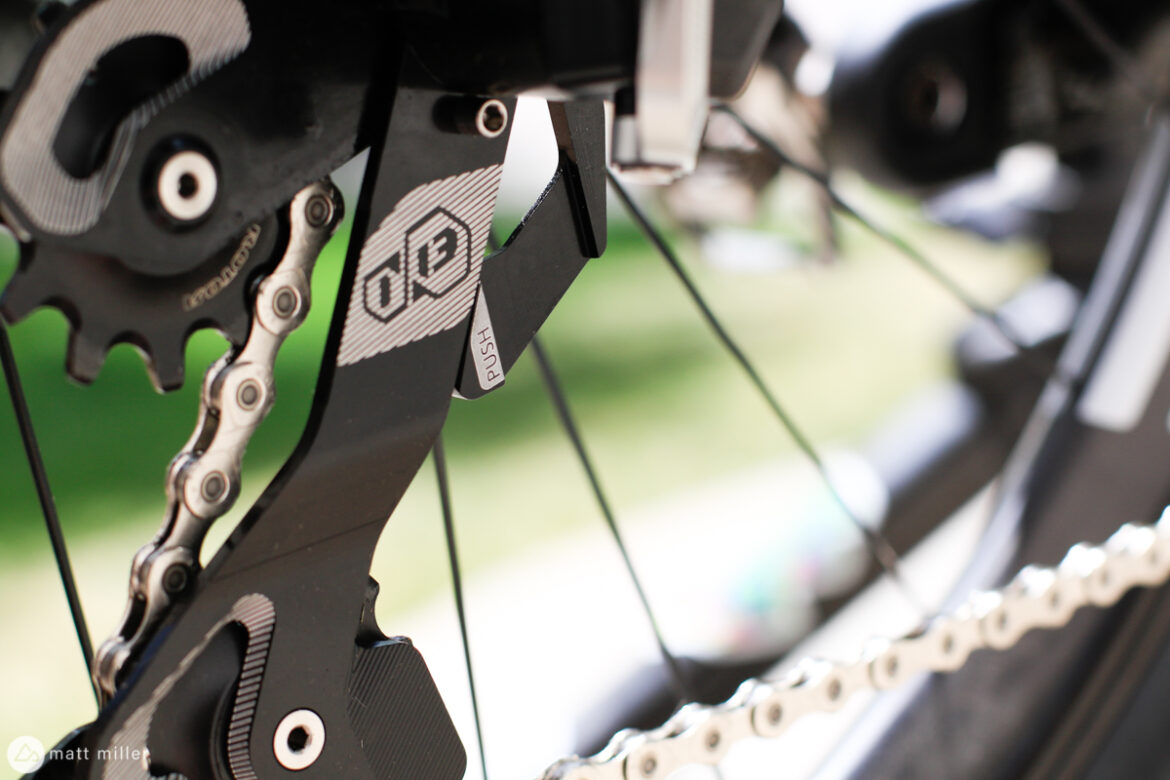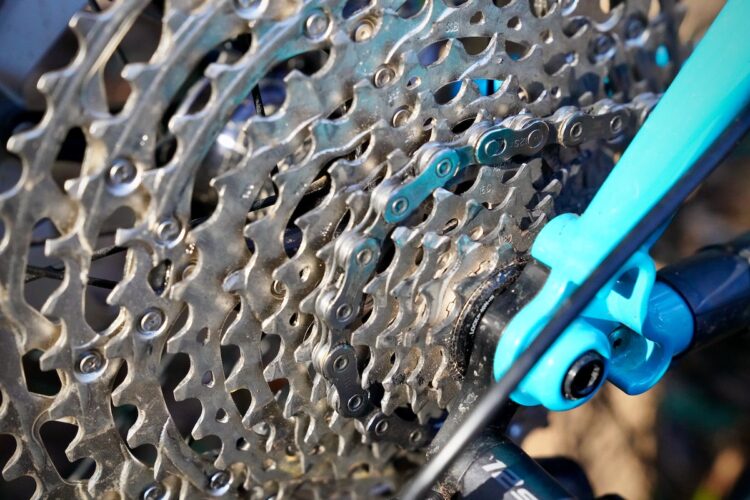
We’ve been following the development of the Rotor 1×13-speed hydraulic drivetrain for about two years now. It’s been a long process for Rotor, but they finally hit the market with the system toward the end of 2019.
SRAM and Shimano usually release some sort of drivetrain development every year, whether it’s dropping a 12-speed drivetrain to rival the other, trickling down technology into more affordable components, or increasing their range ever so slightly. And it’s always entertaining to watch them sort of beat each other. But if you’re tired of the games, there are several newcomers and brands who are trying different things in the drivetrain market. Box, for example, has a 9-speed drivetrain with 454% range that Jeff tested at the end of 2019.

TRP also has two new drivetrains on the market: a downhill focused 7-speed, and a trail ready 12-speed. And then, of course we have the Rotor 13-Speed hydraulic – and if you’re about to X out because 13-speeds sounds ridiculous, the drivetrain can also be used as a 12-speed if hydraulically-actuated systems interest you.
Needless to say, if you’re tired of Shimano and SRAM, or just want to try something completely different, it’s a pretty great time for that. We were able to get our hands on the Rotor 13-speed for about a month of testing. While we obviously can’t say exactly how reliable or durable the system, we got a decent feel for its performance. First, let’s recap what exactly the Rotor drivetrain is, and why folks might be interested in it.
About the Rotor 13-speed

“We’re willfully interested in making things different,” says Lori Barrett, the brand manager for Rotor’s North American division. With SRAM and Shimano both heavily investing in 12-speed, cable-operated, and now electric drivetrains, Rotor saw a hydraulically operated drivetrain having potential.
They had done it already for road applications with their UNO hydraulic 2×11 groupset. By figuring out how to make the hydraulic system in a 1×13 configuration, it would be more applicable to gravel and mountain bikes, and still covers the same range that road riders find in a 2×11, just without a front derailleur. It should also be more reliable.
Right now, the service intervals for the drivetrain are indeterminate. There is no prescribed point where users need to bleed or flush the system. With nowhere near the amount of heat or pressure on the hydraulic fluid that is generated in braking systems, there is less room or potential for poor performance on the drivetrain. Barrett says that she has been using the hydraulic system on her gravel bike for about two years without a bleed.

The system is lighter here and there than competitors, but overall, not so much that it is a game-changer. It eliminates friction and the tension from a cable operated system, by eliminating the cable. This means that it opens up space for the derailleur to work in a completely different manner. The gear indexing happens within the derailleur, and for those worried about severing a hose on the trail, the derailleur can be manually set to a particular gear so it’s easier to get out of the trail – not that most of us carry an extra shift cable in the event of a torn cable.
There are also other features unique to the derailleur – which is universal to their mountain, gravel, and road systems that they offer 1×13. They have four cassette options to suit consumers’ preferences: a 10-36, 10-39, 10-46, and 10-52. However, the 12-speed cassettes only drop down to an 11T.
One nag for many about the new SRAM cassettes which were released in early June, is the drop from 1st to 2nd gear, a 10-tooth jump, from 52T to 42T. Both the Rotor 12- and 13-speed cassettes go from 52 to 44, narrowing the gap. Although the need for a granny gear as large as a 52T is debatable, the sequencing is more attractive on the Rotor cassettes and something that Rotor engineers worked closely with their athletes to develop.

13-Speed Cassette Profiles
- 10-36: 10, 11, 12, 13 , 14, 15, 17, 19, 21, 24, 27, 31, 36
- 10-39: 10, 11, 12, 13 , 14, 15, 17, 19, 21, 24, 28, 33, 39
- 10-46: 10, 11, 12, 13, 15, 17, 19, 22, 25, 29, 34, 39, 46
- 10-52: 10, 11, 12, 13, 15, 17, 19, 22, 26, 31, 37, 44, 52
12-Speed Cassette Profiles
- 11-36: 11, 12, 13 , 14, 15, 17, 19, 21, 24, 27, 31, 36
- 11-39: 11, 12, 13 , 14, 15, 17, 19, 21, 24, 28, 33, 39
- 11-46: 11, 12, 13, 15, 17, 19, 22, 25, 29, 34, 39, 46
- 11-52: 11, 12, 13, 15, 17, 19, 22, 26, 31, 37, 44, 52
The downside of a Rotor 13-speed cassette is that it will only work with a specially developed Rotor hub. The HG freehub body is the same one that they sell on their other hubs, but to make it compatible with a 13-speed, they pushed the driveside flange on the hub 3mm inboard to make room for the 10-speed cog at the end of the cassette. The Rotor Rvolver 13-speed hub is also only available in Boost 148 spacing, so a full 13-speed setup won’t work for SuperBoost 157-spaced bikes and there are currently no plans for Rotor to offer a SuperBoost hub. They say there aren’t enough frames out there to justify making a hub with another standard.
Pricing and weights
The system can be used as a 12-speed, so consumers can just buy the derailleur and shifter, assuming they have a crankset, cassette, chainring, and 12-speed chain. Rotor says that it’s possible to use a SRAM cassette, or another competitor’s cassette, although since Shimano cassettes have different spacing, they are incompatible. MSRP for this setup however is still $999. The 13-speed system is where the price starts to stack up even more.
The derailleur has a feature called The Bolt, and actuating that will set it to work as a 12-speed derailleur. All of the parts, groups, and components are available through the Rotor America or Rotor International websites and they can be found at bike shops that carry Rotor components.
- Shifting set (trigger, derailleur, with uncut, filled hoses): 440g, $999
- 13/12Sp 10-52T/11-52T Cassette: 331/324g (Claimed), $415/ $364 (Price is same for all profiles). My test cassette weighed 300g.
- KMC 12Sp chain: 269g (Comes with the system, if buying separately, other 12-speed chains can be used)
- Kapic crankset/carbon crankset (175mm, 32T w/o BB): 497g/429g, $270/$500
- Rvolver 1×13 front/rear hub: 110g/237g, $155/$344

Rotor offers a few different ways to purchase the drivetrain, as there are a few different ways to make it work. As mentioned, individual components can be purchased from the Rotor website or an authorized dealer, but Rotor sells them in three different kits:
- 1×12 MTB Ready Kit: Includes derailleur, shifter and housing, 12-speed cassette of rider’s choice, KAPIC crankset w/ DM chainring, and a chain. Claimed weight: 1,531g. MSRP: $1,400
- 1×13 MTB Super Light Kit: Includes derailleur, shifter and housing, 1×13 R/F Rvolver hubs, 1×13 cassette, KAPIC Carbon crankset w/ chainring, and a chain. Claimed weight: 1,816g. MSRP: $1,800
- 1×13 MTB Performance Kit: Includes derailleur, shifter and housing, R/F Rvolver hubs, 1×13 cassette, 2INpower crankset/power meter w/ chainring, and a chain. Claimed weight: 2,082g. MSRP: $2,600
Comparing with Shimano and SRAM groupsets, we should look at XTR and XX1 Eagle, since those look like they would be the most comparable components, although we have to look outside of their top component sheets in a few areas since there are a few instances where parts can’t be compared directly on paper.

Cassette: Shimano’s 10-51T 12-speed cassette option weighs a bit over the Rotor option. Gerow weighed the Shimano XTR cassette at 368g before he tested the groupset, almost 70 grams more than the Rotor 13-speed I weighed at home. SRAM claims their new 10-52T 12-speed cassette weighs 372g, so again about 70-ish grams more than the Rotor. The cassettes are two-pieces, of steel and aluminum, bolted together for one piece that feels very light and stays in one nice piece when it’s off the freehub. Rotor’s 12- and 13-speed cassettes are quite a bit more affordable than a SRAM XX1 cassette.
Derailleur/Shifter: We have the XTR derailleur with shifter and cable as weighing 369g total, about 70g lighter than the Rotor offering. The SRAM XX1 derailleur and shifter claimed weight is 388g, these both do not account for the hose weight however, whereas Rotor’s total 440g weight does.

Cranksets: Comparing Shimano’s alloy M9120 XTR crankset with Rotor’s KAPIC crankset included in the MTB ready kit, the Rotor KAPIC is about 30g heavier at 545g, and somehow, almost $200 less expensive than the XTR crankset, selling at $270. The KAPIC Carbon is still $50 less than the alloy XTR cranks and weighs 430g with a 32T chainring, whereas the M9120 weighs 515g, which Gerow weighed with a 34T chainring. Rotor clearly offers a better deal on the crankset.
SRAM’s newest carbon GX crankset weighs a heavier 555g with a 32T chainring and sells for $275. This is very competitive on paper with the KAPIC crankset, although the KAPIC is still lighter, considering it’s alloy.
All in all, aside from the crankset, the weights and prices are fairly similar. We know that the Rotor system should be far easier to maintain, and likely, reliable, leaving the only other thing to judge: performance.
On the trail

It’s fair to say that Rotor had its work cut out, and according to Barrett, it’s something the Spanish brand was OK with. They dug in for years, working around the existing plethora of patents regarding derailleurs, which SRAM and Shimano have had for decades now. “It’s gnarly,” says Barrett. The most challenging part of the development process, she mentioned, was not overlapping existing patents.
My Rotor test drivetrain came equipped on another Spanish machine, an Orbea Occam 140mm-travel trail bike, which Gerow tested in February. The first thing I noticed glancing over the system is the big and boxy derailleur. It’s larger than a Shimano and SRAM derailleur, but is beautifully machined, with mysterious buttons all over.

The indexing referenced above happens on a T30 bolt on the broad side of the derailleur. An instructional video with questionable background music and a narrator that rivals Anthony Hopkins can be found here. The directions are seemingly easy, but with anything in real life, it takes a little more tinkering.
The T30 bolt makes a statement on the derailleur, as does the Go To Origin button, a little knob that drops the chain down to the 13th gear for a slacker chain, and more easily removable rear wheel in the event of a mechanical. There’s also a little clasp on the derailleur cage. Pressing that in allows the upper pulley wheel to rotate downward, slackening the chain even more to get a rear wheel out in record time. It actually does make it easier and less frustrating to get the wheel out of the rear triangle.

There is a bleed port on top of the armored derailleur box. Really the only feature that resembles a normal derailleur is a low limit screw, operated by a 2.5mm hex key, although it’s toward the front of the derailleur. Near the very rear of the derailleur box is an expansion barrel. This allows adjustments to the oil flow throughout the system. Rotating the barrel clockwise basically gives the shifter a tighter and more precise feel, which I preferred.

The shifter took the most time to acclimate to. It’s a single lever and it operates like a SRAM road lever. A shorter “tap” shifts the system up, and a longer “push” shifts it down. During development, there was a second paddle that you could shift up, but Rotor scrapped it, as it didn’t feel ergonomical the rest of the time. That means a cleaner looking cockpit with fewer moving parts.

The downside to my test shifter is that it only allowed a single shift up and a single shift down at once. Aside from the racy touches on the derailleur that expedite time under stress, the shifting felt slower to operate than a traditional ratcheting shifter, and that seems to be the nature of a hydraulically-operated system. Rotor says that a limit bolt for the shifter can be swapped to allow multiple upshifts at a time, but downshifting can only be done gear one at a time.
The shifter moves the derailleur instantaneously, with a tiny bit of lag time when the chain is moving gear to gear. Downshifting to a lower gear is rapid, and upshifting is slightly slower. I wouldn’t say the chain steps are as smooth feeling as SRAM or Shimano. They can feel a little more clunky, especially in the lower gears. The sequencing is really the greatest part about the 1×13 system though. The gears are tighter, and it’s easier to settle into the right gear and find a cadence that feels just right. My 10-46T made for an even tighter profile.

The frustrating thing about the 13-speed cassette on the Orbea was that backpedaling even less than full rotation would cause the chain to fall off 1st gear down toward the middle of the cassette. I tried tuning it out of the derailleur via the indexing bolt as Rotor recommended, but it couldn’t be helped. They say that this has to do with certain chain lines and is dependent on the bike, and since there is an even wider profile than a typical 12-speed cassette, it really angles the chain line.
Unfortunately, this put a big damper on my experience with the drivetrain. Anytime I stopped and needed to rotate my cranks to another position so I could start pedaling again, the chain would drop at the rear, and I’d have to fix it. It’s hard to say exactly which frames would and wouldn’t work with the drivetrain for backward cog retention. Rotor says that it’s all dependent on gearing, spacing, and frame geometry.

There is a more noticeable amount of noise coming from the derailleur on descents as well. The clutch spring doesn’t feel as strong as other derailleurs. This might have also been a patent issue, although Rotor couldn’t elborate. My last nag is on the Rvolver hub. The engagement is not as tight as I’d expect on a premium hub, although it did perform well during my test.
Who’s the Rotor hydraulic drivetrain for?

Although after my test with the 13-speed mountain bike drivetrain I wasn’t exactly sold, I think there are still plenty of reasons to consider Rotor’s new option. Some folks are tired of the traditional mountain bike drivetrains and want to try something different. If the chain line issues are less of a problem with the Rotor 1×12 setup, or depending on the chainline of a different bike, the maintenance-free nature of the system has some serious appeal. The tough part about this is that it’s anyone’s guess as to which frames would or wouldn’t be more friendly. The shifting is smooth however, they have great cassette options, and the different features on the derailleur can make servicing easier.
It also seems like a great option for gravel bikes, and the 12-speed yet again seems like a good option, and a huge upgrade over 11-speed gravel drivetrains which often feel like there are not enough gears for the types of terrain covered. Again, the maintenance-free nature of the Rotor system should fit in well with the simplicity of most gravel bikes.
Closing thoughts

For being a relative newcomer to the drivetrain party, and juking their way through a blockade of existing patents, the Rotor 1×13 system seems largely successful. The drivetrain puts something new in the mountain bike world and not only gives us something to talk about, but also a thinking point.
How bad do we want electronic drivetrains? This looks to be the direction that the major brands will forge next, and I think we’re all assuming that the next step for SRAM AXS is a trickle down of technology into a more affordable groupset. Do we really want more electronics to rely on though, on top or our GPS computers, smart watches, heart rate monitors, and phones?
Then again, cable-operated drivetrains are better than ever, and Shimano’s XT and XTR 12-speed drivetrains have worked blissfully for me on every single bike I’ve had with them. I have yet to have any backward chain retention issues with these groups, and they have been nothing but reliable. Even on my own bike with a Shimano XT/XTR 1×11 drivetrain, I swap shift cables maybe once a year, or twice at most.
However, the mountain bike industry would be nowhere if technology stagnated. I don’t imagine Rotor will stop trying to perfect their new system that they have put so much time and energy into developing and I’m sure it can only get better from here. At the very least, they are off to a great start.





















